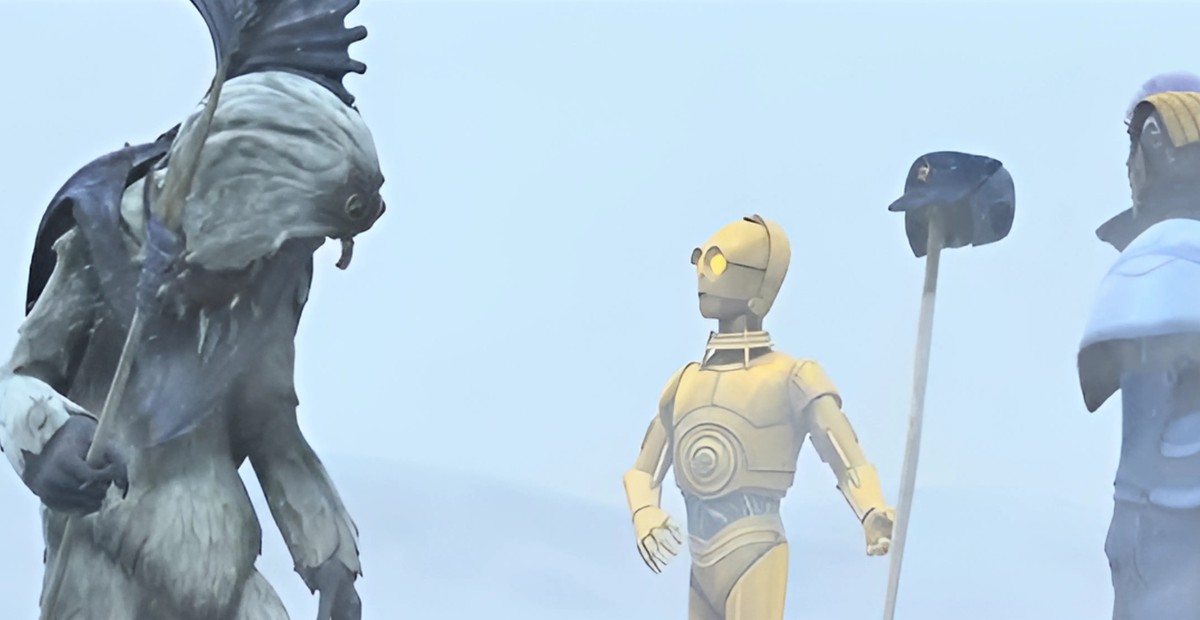When I came across a thread asking how C-3PO was able to speak with the Talz in The Clone Wars episode “Trespass,” the question stuck with me, so I started getting into it. Once I pulled together what’s shown in canon and what’s explained about the droid’s design, the answer turned out to be quite straightforward.
The Talz Weren’t Really “New”
The word “newly discovered” can be misleading. The Talz already had a known homeworld, Alzoc III, which was part of the Republic. The group on Orto Plutonia was simply an isolated tribe that no one had run into yet. That’s what was new.
This makes sense once you recall when a Talz named Muftak shows up in the Mos Eisley Cantina in A New Hope. There are also records of Talz in the Old Republic era, thousands of years before the Clone Wars. The Republic even had them fighting on icy planets like Hoth back then. So when C-3PO meets them on Orto Plutonia, he’s not dealing with a mystery species, just a population that wasn’t cataloged on that specific moon.
The Talz Language Was Already Out There
The Talz language, Talzzi, wasn’t locked away on Orto Plutonia. Since the Talz were already part of galactic history through Alzoc III, their language was in Republic databases. A protocol droid like C-3PO, with its TranLang module, would have been equipped to handle it.
Even if the Orto Plutonia tribe’s way of speaking had shifted a bit over time, C-3PO had the processing power to bridge the gap. He could take what he already knew of Talzzi and adjust on the spot. That’s how he worked with the Ewoks too—picking up enough from their speech and behavior to translate and respond.
C-3PO’s Design Gave Him The Upper Hand
C-3PO is a 3PO-series protocol droid, equipped with a TranLang III communications module and an AA-1 VerboBrain. That combination is what makes him fluent in over 6 million forms of communication.
The TranLang module carries massive libraries of known languages, but the real magic comes from the VerboBrain. That’s the part that lets him recognize dialects, patterns, and context. He doesn’t just spit out pre-programmed translations. He can adapt, cross-reference, and come up with a working translation even if the dialect is something he hasn’t studied word-for-word.
I remember when he admitted during the Orto Plutonia encounter that he didn’t have the exact dialect of the Talz. Instead, he was able to communicate using something close enough to get the point across. It’s like when someone who speaks Spanish talks to someone who speaks Italian. You may not have every word right, but you can understand enough to have a conversation.
So when C-3PO stood there translating between Senator Chuchi and the Talz chieftain, he didn’t have to know every nuance. His VerboBrain and programming let him fill in gaps almost instantly. Even with an isolated colony, the similarities in the Talzzi dialect gave him enough to work with.
The Story Outside The Galaxy
Behind the scenes, George Lucas and the Clone Wars team created the Talz for “Trespass” as a way to tell an allegory about indigenous peoples defending their land. The language barrier was important for that story, and C-3PO was the bridge.
But the in-universe explanation holds up too: the Talz weren’t a brand-new species, their language already existed in Republic records, and C-3PO had both the tools and the adaptability to make communication possible.

